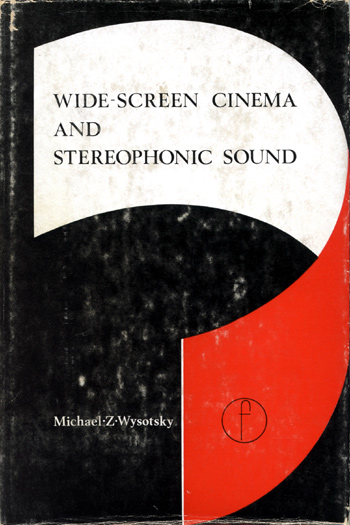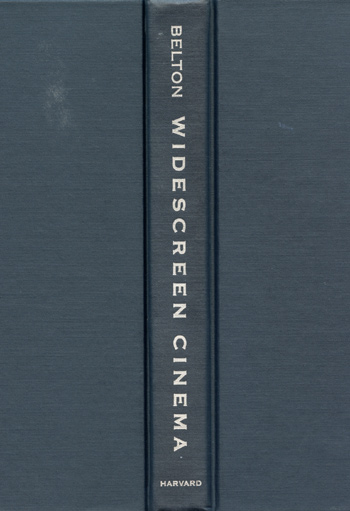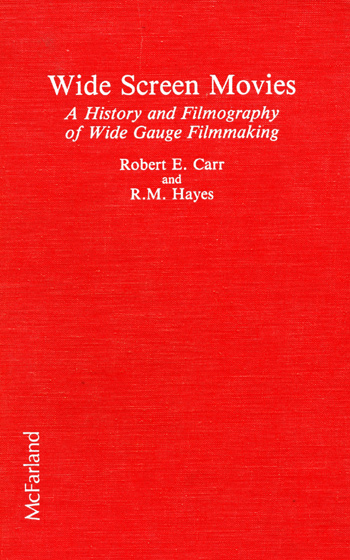Introduction to Projection and Wide Film (1895-1930) | Read more at in70mm.com The 70mm Newsletter |
| Written by: Rick Mitchell Film Editor/ Film Director/ Film Historian. Work published posthumously | Date: 15.03.2014 |
 Rick
Mitchell passed away in September 2011. Photograph by Tom March. Rick
Mitchell passed away in September 2011. Photograph by Tom March.
Rick Mitchell and I corresponded a lot over the years, and he was a very active writer on this web site. Some days before he passed away in 2011, we talked about his book about Wide Screen, which had been in-progress for many years. In 2004, he sent me this chapter outline of his book: I. Introduction II. Prologue A. W.K.L. Dickson and the Establishment of the 1.33:1 Frame (1891-1908) III. Commercial Wide Screen Processes and Systems (1929-1963) A. Why a wider image became desirable in the Twenties B. Magnascope (1926-53) C. Early Wide Film (1929-31) D. The development and introduction of Cinerama (1936-52) E. The development and introduction of CinemaScope (1927-53) F. Non anamorphic alternatives to CinemaScope 1. Masked projection (1.66:1, 1.85:1, etc.)(1953- ) 2. VistaVision (1953-60) G. Photographic and optical anamorphic alternatives to CinemaScope 1. Vistarama (19530 2. Cinepanoramic, Naturama (1953-@65) 3. Superscope and later uses of the technique (1954-@65) 4. Panavision (1957- ) 5. Techniscope (1963-75) H. The return of wide film (1953-65) 1. Todd-AO (1953- ) 2. CinemaScope 55 (1955-56) 3. Camera 65/Ultra Panavision (1956-66) 4. Super Panavision (1958- ) 5. Dimension 150 (1965-70) 6. "Wide Frame" I. Horizontally projected VistaVision (1954-57) II. Technirama (1956-67) IV. Wide Screen's effect on other areas of production and exhibition A. On editorial, visual effects, and the laboratory B. On theatrical documentaries and shorts C. On nontheatrical exhibition and amateur filmmaking V. Economic aspects VI. Wide screen aesthetics VII. Epilogue (1970- ) His book was far from finished when he suddenly passed away, but he did finalize the first chapter: Projection and Wide Film (1895-1930). Here's his e-mail from 9. September 2011 I realized that it would probably take ten years to do the book I want to do and who knows if there will still be books then or enough people interested in this subject to get someone to publish it. I'll have to think about doing the first two chapters on in70mm.com when I'm feeling better, if that ever happens. Rick Mitchell Film Editor/Film Historian .....and 3 days later, 12 September 2011, Rick sent me his finished chapters for in70mm.com Thomas, in70mm.com | More in 70mm reading: • Prologue to Projection and Wide Film • Projection and Wide Film (1895-1930) • Rick Mitchell, interview, July 2008 • Who is Rick Mitchell? • Rick Mitchell - A Rememberance • Wide Screen Motion Pictures • 70MM Come Back!!! • The Wide Screen Revolution • "The Bat Whispers" in 65mm Internet link: |
Early Wide Film Experiments | |
|
It is the intention of this book to deal with the subject of “Wide Screen“
as it relates to the mainstream theatrical motion picture industry and its
history, with reference, where appropriate, to its effect upon such related
areas as documentary, industrial, and non-theatrical production and
exhibition. Notable techniques and processes, the events and situations
within the industry which precipitated their introduction, and the
subsequent loss of popularity of some them will be covered mostly in
chronological order as new developments were generally founded upon, or a
reaction to, a previous one. What is meant by “Wide Screen” and why is it important in the study of theatrical motion pictures? The term “Wide Screen” has had three basic meanings since it was first introduced into the industry’s lexicon in January, 1953 . Initially it referred to the projection of a motion picture image onto a screen wider than the squarish 1.33:1 (or, since the introduction of sound, 1.37:1) aspect ratio that had been standard since the beginning of projected movies. Later in 1953, it was applied to the practice of projecting a wider image for films photographed at 1.37:1 by masking off the top-and-bottom of the frame to aspect ratios ranging from 1.66:1 to 2:1 in projection onto screens of corresponding width. Since the latter has become the standard method for the theatrical presentation of films photographed with spherical, or non-anamorphic lenses, today the term “Wide Screen,” when applied to theatrical presentation, usually refers to those films requiring an anamorphic lens for 35mm projection regardless of their method of original photography. , though in recent years, primarily with regard to video, it has again been colloquially applied to any frame wider than the basically square one. Motion pictures are a technological medium and the course of its over 110 year history has been significantly altered by two technological developments, the introduction of sound in the late Twenties and the adoption of Wide Screen in the early Fifties. The latter did change the look of motion pictures, but it proved only a temporary hedge against the post World War II boxoffice decline, unlike sound had done just before and during the Depression. But for many young moviegoers who grew up in the Fifties and Sixties, trade names like Cinerama, Cinema-Scope, Panavision, and Todd-AO were “open sesames” to the most magical vistas the motion picture screen could present, especially the latter which was associated with the spectacular roadshow films shown in opulent downtown movie palaces. Those who were lucky enough to become filmmakers as adults would embrace the various Wide Screen formats; some, like John Carpenter and George Lucas, working in it exclusively. | |
 Wide-Screen Cinema &
Stereophonic Sound by Michael Z. Wysotsky (Hastings House) Wide-Screen Cinema &
Stereophonic Sound by Michael Z. Wysotsky (Hastings House)Unfortunately, only recently have contemporary audiences been able to enjoy an approximation of this experience with current films, shown in those theaters that have replaced many of the tiny multiplex shoebox auditoriums of the Seventies and Eighties. Unfortunately this is also a compromise as the “large screens” of newer theaters are being designed to favor the “taller” 1.85:1 ratio, with films in the “wider” 2.40:1 anamorphic ratio being projected in an overall reduced size in their center, just like video “letterboxing!” This is the source of current curiosity and interest about “Wide Screen”. This stems from the incompatibility between the old square TV tube and the wide anamorphic or 70mm image. In order to present as much as possible of the full width of the latter within in the former, it is necessary to reduce the size of the overall image. This is the antithesis of the intent of filming in those formats and severely reduces the impact of the images, especially when viewed on very small screens, such as those of a laptop computer. Many of the video oriented can’t understand why an image filling only 2/3rd of their screens is more desirable than the normal one that fills it and cannot comprehend their elders’ enthusiasm for films like LAWRENCE OF ARABIA (Columbia; 1962), HOW THE WEST WAS WON (MGM-Cinerama; 1962), or 2001: A SPACE ODYSSEY (MGM; 1968) when they’ve only viewed them on the tube. The decreased availability of 35mm or 16mm anamorphic prints of older films has limited the opportunity for the even film students, much less the general public, to view most “Wide Screen” classics in any approximation of the way they were meant to be seen and has also hampered the ability of scholars to properly study them to deal with many of the conflicts, confusions, and errors that have arisen over the years. (Video, both “pan/scan” and “letterboxed”, is useless, particularly for studying some highly technical aspects such as image resolution, for example.) This problem is rooted in the love/hate relationship theatrical exhibition has long had with television. One of the reasons the industry jumped on the Wide Screen bandwagon was an attempt to attract audiences with a visual experience different from that they could obtain from the tiny tube sets of the time. This point was made emphatically, for example, in the 1954 version of 20th Century-Fox’s annual product reel for exhibitors, with a sequence showing how a spectacular wide shot from Broken Lance would look on TV, at 1.85:1, and finally at the then standard 2.55:1 of CinemaScope. At this time the thinking was that films made after mid-1948 would never be shown on TV, as American International so advertised its 1958 double bill of The Bonnie Parker Story and Machine Gun Kelly, released theatrically in the anamorphic ratio, though the original photogra-phy was spherical. But, because the Hollywood studios found new sources of revenue in selling or licensing their old libraries to the new medium, making newer releases available was inevitable, facilitated by concessions made with the Screen Actors Guild during a 1960 strike. | |
 Widescreen Cinema
by John Belton (Harvard University Press; 1992) Widescreen Cinema
by John Belton (Harvard University Press; 1992)Unfortunately, an aesthetic problem cropped up with regard to anamorphic or 70mm films: an FCC ruling requiring the full 1.33:1 frame be broadcast over the air. This meant only a selected half of the total width of such images could be telecast, as opposed to an overall reduction of the image in order to broadcast it at full width or a representative portion thereof, as was being done for the 16mm non-theatrical market . Film fans tolerated this unsatisfying approach until the rise of cable services and the availability of films on videotape and laserdisc in the late Seventies. As these distribution mediums were not bound by the FCC rule, which was rescinded in the 1980s, purists clamored for video versions of anamorphic and 70 mm films in the “letterbox” format, which became so popular, especially on laserdisc, that nonanamorphic post-1953 35mm films were also released “letterboxed” to match their theatrical 1.66:1-1.85:1 theatrical projection format. And in 1976 when Japan’s NHK began its work on High Definition Television, they chose the wider 16x9 or 1.77:1 aspect ratio. (Interestingly, a decade earlier production designer Tony Walton and/or art director Syd Cain had chosen a similar ratio for the futuristic view-screens in Francois Truffaut’s Fahrenheit 451.) Though in subsequent years there have been arguments in favor of both wider and narrow aspect ratios for HDTV, 16x9 has stuck and has been accepted for “Wide Screen” displays for standard TV presentations. Since what works on a large screen in a large auditorium does not necessarily work in the smaller environments in which TV is viewed, in recent years the compromise between the needs of the two mediums has negatively affected the use of wider aspect ratios for theatrical release, especially with regard to original photography using anamorphic lenses or higher resolution 65mm negative for 70mm prints. The majority of “Wide Screen” features released in the last few years have been photographed in the Super 35 format, squeezed optical or digital extractions from spherical photography with all important action kept within the 2.40:1 aspect ratio from which taller 16x9 HDTV and 1.33:1 regular video transfers can be easily made. Like most of motion picture history, over the years a lot of misinformation has encrusted the truth about the various techniques the industry has adopted or experimented with to achieve a “Wide Screen” image, especially since it has only been in the last thirty years that the technological history of the art and industry has been researched and written about by people who had enough of a working knowledge of the subject to deal with it properly. Since the late Fifties the subject has been dealt with in passing in most film histories with only three books devoted exclusively to it. | |
 Wide Screen Movies by Robert E. Carr and R.M. Hayes (MacFarland,
1988) Wide Screen Movies by Robert E. Carr and R.M. Hayes (MacFarland,
1988)The first was published in the United States in 1974, the English translation of a book originally published in Russia, Wide-Screen Cinema & Stereophonic Sound by Michael Z. Wysotsky (Hastings House). While interesting in its look at the use of various wide screen techniques in the U.S.S.R., though there has been some debate about its honesty, the first section of the book dealing with Western developments was primarily gleaned from articles in publications like the Journal of the Society of Motion Picture (and Television) Engineers and the American Cinematographer. In the last twenty years there have been two more books devoted to the subject of Wide Screen. Widescreen Cinema by John Belton (Harvard University Press; 1992) places the subject in an historical sociological context but deals primarily with the unsuccessful attempt to introduce Wide Film in 1929-30 and the development of Cinerama, CinemaScope, and Todd-AO. It is enriched by Belton’s access to the archives of Earl I. Sponable now housed at Columbia University in New York. Mr. Sponable headed the Fox Film Corporation and later 20th Century-Fox’s research department and was not only involved in the development of Grandeur, CinemaScope, and CinemaScope 55, but was a member of the S.M.P.(T.)E. and other professional organizations and kept abreast of all technological developments going on in the industry, including those in which he and his company were not directly involved. Such references do not inform the third and most controversial book on the subject, Wide Screen Movies by Robert E. Carr and R.M. Hayes (MacFarland, 1988), a work ridden with errors and suppositions by the authors. If they did do any research in Los Angeles, it’s significant that their acknowledgements do not list anyone from Panavision, Technicolor, or 20th Century-Fox, a necessity if one’s goal is to do an accurate study of the subject. That is the goal of this book, which began as a potential article for the American Cinematographer that was serialized in The Operating Cameraman magazine in the Nineties. It is one of the first such works to be written by someone actually employed in the industry, as a film editor in this case, who not only has pursued information on this subject of lifelong interest throughout his career, but has actual working experience with some of the technologies discussed, primarily as assistant film editor on "Star Trek-The Motion Picture" (Paramount; 1979), whose principal photography was done in 35mm anamorphic with Panavision equipment, while visual effects elements for it were shot in both 65mm and VistaVision. The author has also shot extensive anamorphic footage in Regular 8mm, 16mm, and in one instance, 35mm. The author is fortunate in having the following agree to be advisors on the book in verifying its accuracy: visual effects cinematographer Peter Anderson, ASC; John Belton; historian Robert S. Birchard; Michael Coate of fansofshowmanship.com; visual effects artist Jim Danforth; Herbert E. Farmer, professor emeritus of the University of Southern California School of Cinema; Martin Hart of widescreenmuseum.com; Thomas Hauerslev of in70mm.com; cinematographer John Hora, ASC; historian and preservationist Scott MacQueen; Richard P. May, former vice-president in charge of preservation for Warner Bros. and Turner Entertainment; Gary J. Prebula, producer and professor in the Film and Electronic Arts Department of the California State University Long Beach, Paul Rayton, historian and chief projectionist for the American Cinematheque; and engineer Daniel J. Sherlock, who is like his namesake detective in determining the accuracy of technical aspects of the various processes. Other professionals have expressed interest in vetting specific aspects of the work. It is my hope to straddle the line between providing reasonably in-depth knowledge to students and others interested in this subject while also being informative and entertaining to the general reader. • Go to W.K.L. Dickson and the Establishment of the 1.33:1 Frame • Go to Projection and Wide Film (1895-1930) |
Wide
Screen Movies Corrections, Revision 2.0 - Revised December 2004
Copyright Daniel J Sherlock, 2004 |
| Go: back - top - back issues - news index Updated 22-01-25 |
